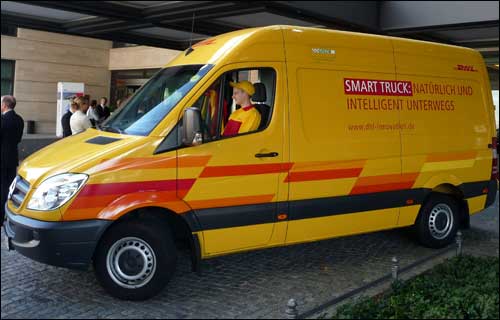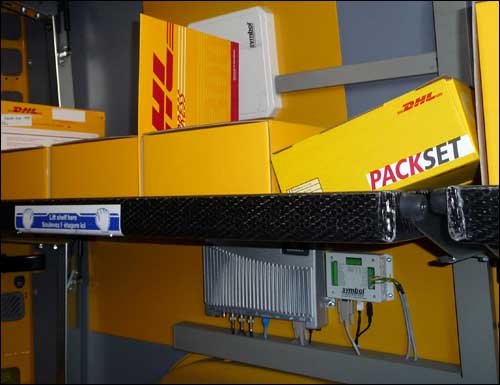DHL, the global package delivery service division of logistics giant Deutsche Post DHL, reports that its SmartTruck initiative, which integrates RFID into its delivery trucks to enable faster package handling, has accomplished many of its goals. Nonetheless, the company indicates, the project is not ready to proceed to the deployment phase, because the technology has not yet achieved a 100 percent read rate of tags by the truck-mounted RFID interrogators.
“We are satisfied that the SmartTruck has passed the technology field trial,” said Keith Ulrich, DHL’s leader of technology and innovation management, at a press conference held in Berlin on Sept. 22 to announce the project’s initial results. “The hoped-for savings in fuel consumption and carbon dioxide emissions have occurred. Moreover, the punctuality of the pick-up and delivery of shipments increased significantly.”

In addition, Ulrich says, thanks to the use of radio frequency identification, customers could not only track the exact route of a package they were expecting, but also receive notification, via SMS text message, regarding the anticipated delivery time.
Ulrich cautioned, however, that before DHL can more widely deploy the technology, it first needs to refine the system’s ability to read passive ultrahigh-frequency (UHF) RFID labels affixed to packages on two specially modified Mercedes-Benz Sprinter delivery vans.
“We have found that in some cases, the RFID technology has not achieved the desired 100 percent read rate,” Ulrich explained. “Therefore, we’re working on an additional project to improve the RFID technology.”
DHL’s SmartTruck initiative employs not only RFID, but also a navigation system that uses real-time traffic data to improve route planning, reduce total miles driven and increase the efficiency of package pickups and deliveries. The technology was developed at the DHL Innovation Center, with contributions from the Federal Ministry of Economics and Technology, the German Aerospace Center (DLR), the German Research Center for Artificial Intelligence (DFKI), Infoware, Motorola and Quintiq.
Since Apr. 1 of this year, two specially modified delivery vans belonging to the DHL fleet have been piloting the technologies in Berlin. Each vehicle has been outfitted with a Symbol (Motorola) XR 480 RFID interrogator connected to an onboard computer. When asked, neither Motorola nor DHL would reveal the cost of the equipment or the RFID portion of the trial.
“Most of the time, you have fixed readers in a warehouse,” said Ward Vermoere, a Motorola account director who worked on the project. “Having it on wheels is pretty unique.” Once gathered by the RFID system, the van’s inventory data is linked to DHL’s network via the vehicle’s onboard computer, so that real-time data on the packages is available for customers. Currently, manifest information is kept up to date through bar-code scans.

To ensure maximum communication between the tags and readers, the Sprinter vans’ cargo bays are wired with six Motorola RFID interrogator antennas, and the steel shelving used to hold packages has been replaced with carbon-fiber shelves, in order to reduce interference caused by metal. To lessen the impact of road vibration, the antennas are mounted on a special plate to the wall of the van.
The RFID labels, which operate at 865-868 MHz and comply with the EPC Gen 2 standard, are supplied by GM Consult IT and are made with UPM Raflatac inlays containing chips from NXP Semiconductors. Currently, the labels are applied to the packages by hand. Were the system to be more widely deployed, said project leader Boris Paul, packages would be automatically tagged once DHL receives them.
According to Paul, the interrogators accurately track packages when “a few” are being removed from the vehicle at a time. The less-than-100-percent read rate issue stems from the types of conditions that delivery drivers often face in the field. When drivers hastily pull out a stack of variously sized envelopes, Paul said, the devices often have difficulty scanning items in the middle of the stack.
“You have to imagine that in the express business, there are lots of parcels that come in large envelopes—CDs, books, that sort of thing,” Paul explained. “When the driver arrives at a delivery address with multiple parcels stacked together to deliver, they just jump out of the van and go.”
The express delivery business has also changed in the past two to three years, Paul noted, which has contributed to the problems involved in reading the tags properly. He described seeing flat-screen televisions and full cases of beer’ moving through DHL’s sorting depots and going into the delivery vehicles. Beer and other products containing water absorb RF signals, while TVs and other objects with a lot of metal components reflect RF signals. Therefore, Paul said, large packages containing water or metal can create a shadow that disrupts a tag’s signal, making it difficult to identify packages within a van.
DHL is optimistic the issue can be resolved, and is presently working to fix the problem, in cooperation with the Fraunhofer Institute, a contract research organization in Magdeburg, Germany, that is partially government-sponsored.
“Anything far under 100 percent read rates is hard to sell” as a business case to DHL’s top executives, Paul stated. “Once we get there, there’s a business case for the technology, at the very least in our depots.”
Although Paul could not name a timetable for a wider deployment of RFID aboard DHL’s trucks, he said the company is evaluating the technology for a number of purposes related to its package delivery business. Once deployed, RFID tags could replace the practice of employing bar-coded labels and scanners to track packages and streamline operations, both in parcel-handling hubs and for delivery drivers, who would then be spared multiple bar-code scans of packages.
As part of the follow-on project to improve the reader’s performance, DHL also plans to test a “pick by light” system that integrates with a vehicle’s onboard computer, identifying which packages will be delivered at the driver’s next stop. The system will utilize RFID to locate a particular package on a van’s shelf, and lights installed at regular intervals on those shelves will guide the driver to the correct item, thus hastening the delivery process and reducing driver errors. The company is working with multiple vendors to develop the system, Paul said.
According to Paul, Deutsche Post DHL hopes its SmartTruck initiative will help it achieve its goal, set in April 2008, of improving the CO2 efficiency of its operations by 10 percent by 2012, and by 30 percent by 2020.

